The Three Clusters Of Lalibela Rock Churches
- The Northwestern Cluster
- The Southeastern Cluster
- Saint George’s Church (which stands apart from other clusters)
When to Visit
How To Get There (Car, Bus, Plane)
Where to Stay
Where to Eat
Entrance fee to Lalibela
Climate and Weather
What to Wear
Photo, Video, Drone
Extra Tips
Lalibela is a small medieval town in the Amhara region formerly known as Roha in present-day Ethiopia. It was later changed to Lalibela named after King Lalibela who built the monolithic churches in the midst of Lasta mountains of northern Ethiopia. Lalibela is home to 11 unique historical architectural sets of church designs. King Lalibela built the churches in the 12th century as a pilgrimage centre for those who could not make it to the ‘Holy City’ of Jerusalem. The structures were carved out from rocks of monolithic blocks from the mountainous landscape.
The Three Clusters Of Lalibela Rock Churches
Each church was created first by carving a wide trench on all four sides of the rock. Then the interior and exteriors were painstakingly handcrafted with chisels and hammers. Due to the complexity of the structures, some legends believe angels had a hand in building the churches. The churches are over 900 years old, and also regarded as UNESCO World Heritage site. These are some of the oldest churches in human history and one of Ethiopia’s lead tourist destinations.
There are a total number of 11 rock churches in Lalibela. Some of which are monolithic, a few semi-monolithic and the rest are carved into the rocks. These churches are segmented into three clusters. One day is enough to cover all 11 churches but if you desire in-depth experience a two-day visit is recommended.
- The Northwestern Cluster
- The Southeastern Cluster
- Saint George’s Church (which stands apart from other clusters)
For most tourists, the usual route starts from the main entrance at the biggest church, Biete Medhane Alem and ends at St. George’s church
1. The Northwestern Cluster
There are five churches in the Northwestern cluster, grouped North of River Jordan. These churches have the most stunning and impressive artistic designs. They are attached to the ticket office and linked to each other:
Biete Medhane Alami (House of the Savior of the World)
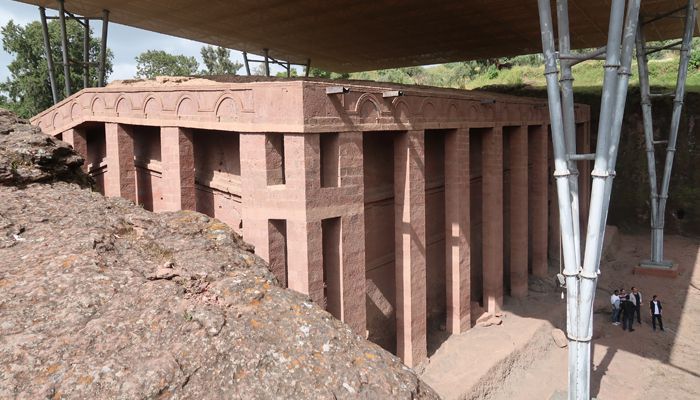
This is the largest and artistically the most impressive church. It has 72 columns symbolizing 72 disciples. The main pillars are located outside rather than inside, while the layout of the church resembles that of the ancient Aksum Cathedral destroyed in the 16th century. The entire church from doors, window, vaults, pillars are carved from within a single rock to look like a building.
Biete Mariam (House of St. Mary)
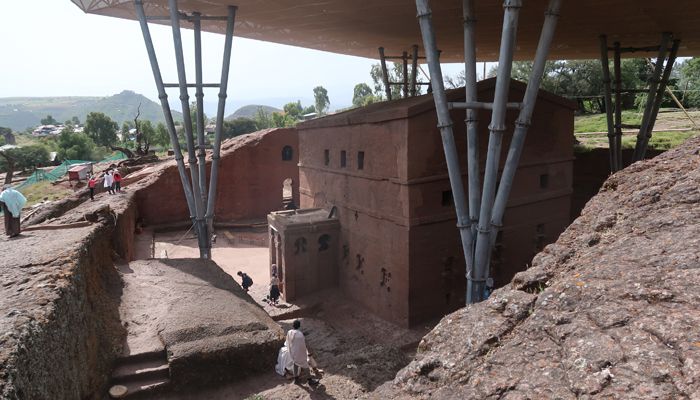
This church can be linked from Biete Medhane Alem through a short tunnel. Of all the churches, this one features more paintings and details on the wall and ceilings. Some of the significant paintings include the bullfighting, Mary fleeing Herodes and faces of the 24 elders. This was described as the first church that was built. For obvious reasons, the interior of the church has been immaculately preserved. The Church of St. Mary is said to be one of the most popular amongst pilgrims.
Biete Maskal (House of the Holy Cross)
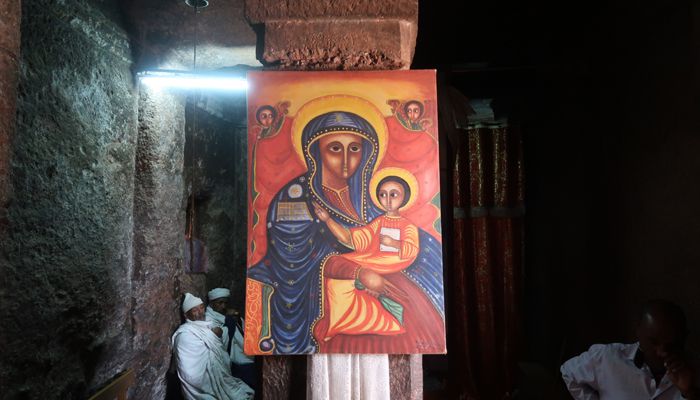
Compared to others, this church is smaller, longer and more narrow. The interior has four pillars which are symbolic representations of four evangelists. Carved into the northern wall surrounding Biete Mariam, this small chapel features a prayer hall and a separate changing room.
Biete Denagel (House of the Virgins)
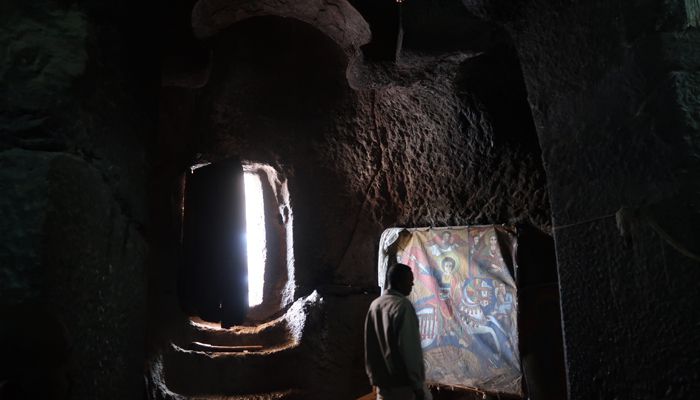
This church is located in the courtyard of Biete Mariam carved into its southern wall. It has fewer details and rougher walls, and was dedicated to 36 martyred maiden nuns ordered to be executed by the 4th century, Roman Emperor Julian.
Biete Golgotha Mikael (House of Golgotha)
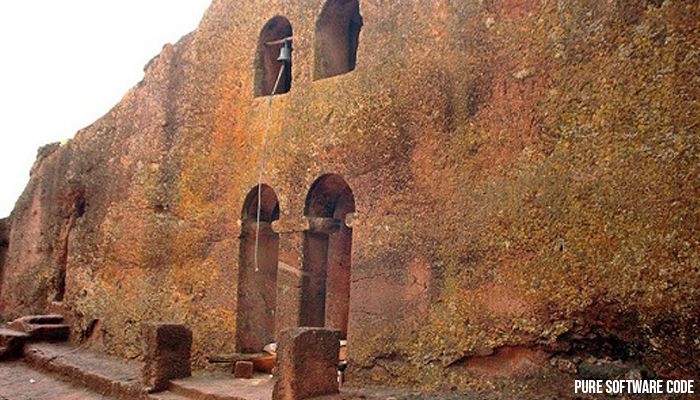
This church is highly regarded as one of Lalibela’s holiest sites. It is said to be the final resting place of King Lalibela – who many consider a Saint. The tomb is cryptic, covered with large stone under the floor of Golgotha church. There is a hole located in the middle of the church. This hole is said to link to the Saint’s grave and pilgrim’s extract dust from there with faith to cure diseases. Unfortunately, this church is not accessible to women.
2. The Southeastern Cluster
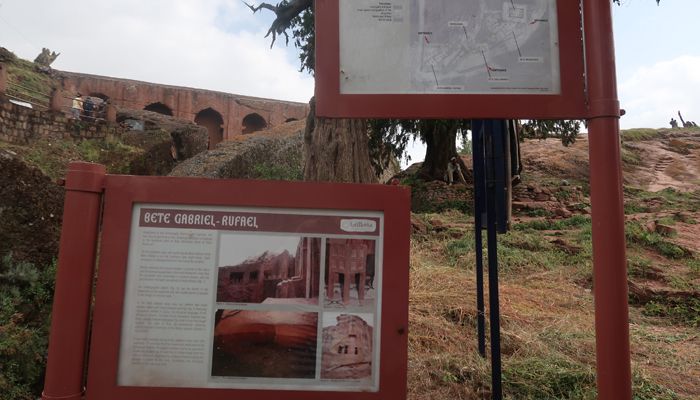
This set of churches are just a stone-throw away from the first sets. They are called the Southern cluster because they are grouped south of River Jordan. There are lots of differences compared to the Northern cluster in terms of architecture and style. This group features more intricate exteriors and structural variations. They are connected by a maze of tunnels and trenches.
Biete Gabriel Raphael (House of Gabriel and Raphael)
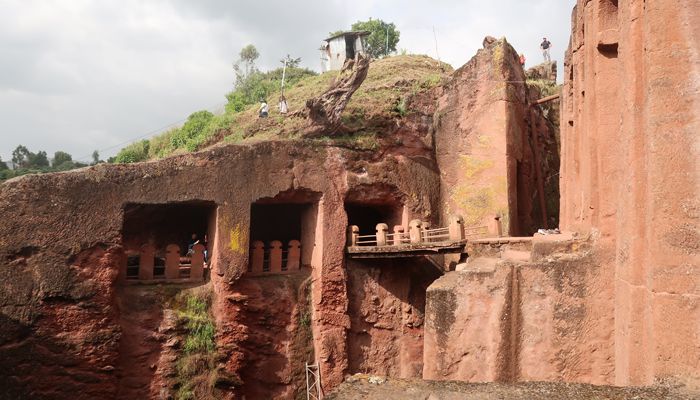
This church has one of the most distinct architectural layouts amongst others. It is located at the entrance of the Southeastern cluster churches. Biete Gabriel Raphael is a twin church that can only be accessed from its top through a rock bridge known as the ‘way to heaven’. The unique things about this church are the irregular floor plans and the absence of a holy room. Because of this, scholars believe this may have been a fortified palace rather than a church.
Biete Qeddus Mercoreus (House of Mercoreus)
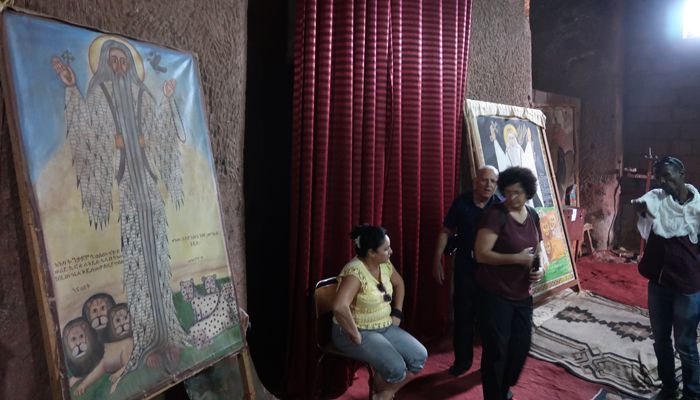
This church symbolizes paradise. Its pillars are huge compared to other churches with rough walls and the roof has no details. This church was thought to have been used as some kind of prison or justice court due to the discovery of ankle shackles here. The Church is connected to Biete Gabriel-Raphael via series of tunnels and trenches. Wandering around these maze of tunnels is an experience on its own.
Biete Amanuel (House of Emmanuel)

This church has an amazing exterior styled like that of an Aksumite building. It is a two-story building with attractive details and final touches. The monolithic church is perfectly carved on its exterior with blind windows that represents Noah’s Ark. The church symbolizes ‘Heaven’ and it’s said to be the chapel of the royal family.
Biete Abba Libanos (House of Libanos)
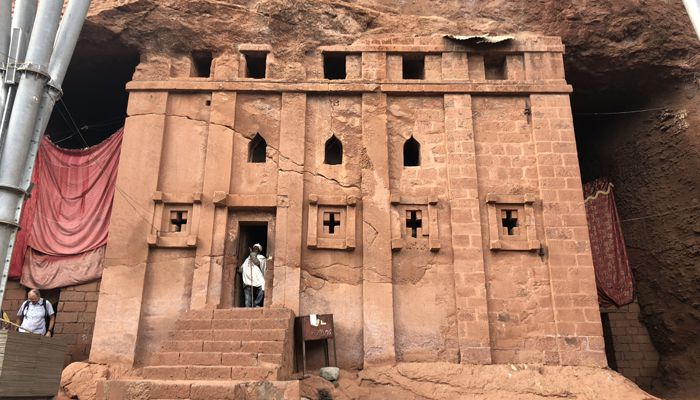
Biete Abba Libanos is unique because it’s the only grotto church in Lalibela. The roof and floor of the church are attached to the rock but the walls are totally separated having just one huge pillar. The church is surrounded by a large cave used for drumming and chanting during mass and other religious activities. The church may look big outside but it’s actually narrow inside.
Biete Lehem (House of Holy Bread)
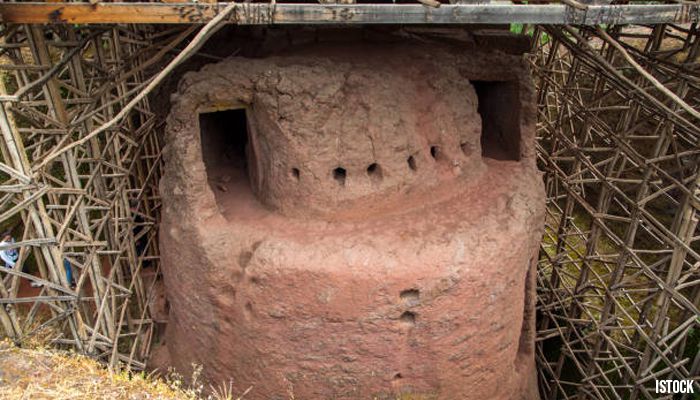
This is another underground monolithic church carved into the rock. The church is connected to Biete Mariam of the Northwestern cluster. Through an underground tunnel from Biete Lehem known as ‘descending into hell’, you can emerge in ‘heaven’ at Biete Mercoreus.
3. Biete Ghiorgis (House of Saint George)
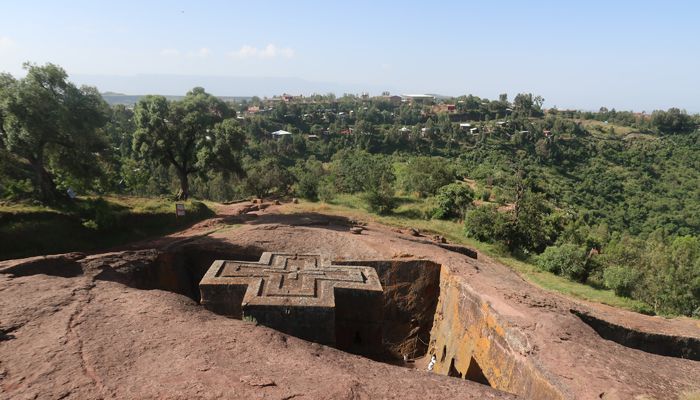
Biete Ghiorgis undoubtedly has the most beautiful architectural designs in Lalibela. This outstanding monolithic edifice was the last church built in the area. With nice views of the surrounding landscape, Saint George is often featured in pictures and books. The church is easily identified instantly from its perfect cross shape, which can be seen from the elevated ground. It’s the only church that stands apart from the northern and southern clusters. It has also miraculously withstood environmental wear and tear for centuries. Despite the impressive architectural designs, the interior of the church is quite modest featuring an altar, a few paintings, and a prayer hall. The atmospheric condition of the church is amazing, especially at dawn.
When to Visit
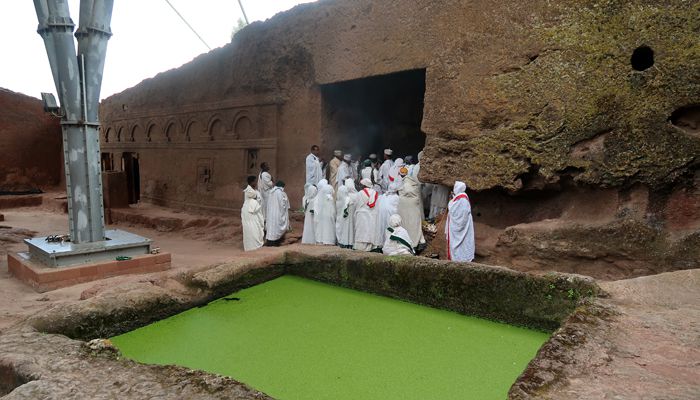
Lalibela churches are open all year round to both locals and tourists alike. However, the sites are a lot busier with tourists during religious festivals. Some of these festivals are Gena, the Ethiopian Christmas, which falls on 7th January, when families gather to enjoy doro wat (chicken stew) and Injera. Then there’s Timkat (the Orthodox equivalent of epiphany falls on 19th January) and Meskel (Holy cross day on 27th September).
These religious events attract pilgrims from all over Ethiopia and beyond. During these festivals, you are able to see the significance of the site to Ethiopian Orthodox Christians. Worthy of note is the fact that hotel rates dramatically increase during this period due to the influx of pilgrims and tourists.
The churches are most active during the early hours of the day (around 6 am). At this time, you can witness locals and pilgrims do their prayers and chants. These dedicated pilgrims make the church come alive and this also enhances the experience. Sundays are worship day for locals and is also a good day to schedule your visit.
How To Get There (Car, Bus, Plane)
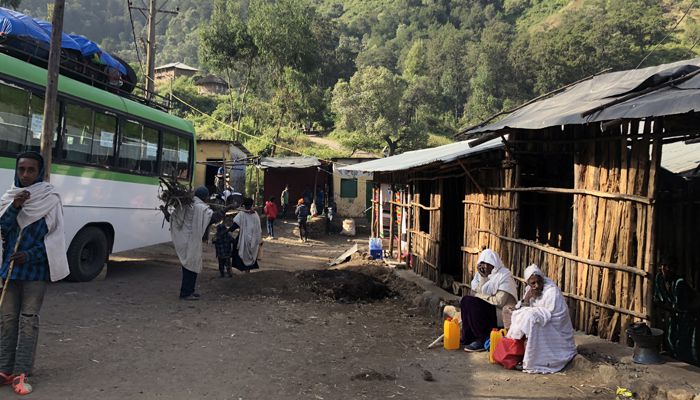
You can access Lalibela by either car, bus or plane depending on your choice of transportation.
Car
With a car, you can access the small town of Gashena south of Lalibela from Bahir Dar and Gondar to the west, and Woldia to the east. The drive from Bahir Dar takes between 7-9 hours and from Gondar, it’s about 10-12 hours. You can also opt for private drivers which would cost around 2,000-4,000 birr depending on your negotiating power. There is also another route north of Lalibela coming from Axum and Adua through an unsealed road. However, it’s easier and faster to take the sealed road via Adigrat and Woldia.
Bus
Daily buses are available from Addis Ababa to Lalibela. It’s a 2-day journey with an overnight stop at Dessie. You can also board buses from Woldia leaving at dawn. Both buses from Woldia and Addis Ababa depart Lalibela at 06.00 hours. Buses are also available to and from Bahir Dar in one day, changing buses at Gashena. This would take about one or two bumpy hours from Lalibela depending on traffic and weather. Travelling by bus from Gondar will require you to spend the night somewhere. Coming from Axum, it will take about two nights with stopovers at Makelle and Woldia. The next day you can board another bus headed to Bahir Dar with a stop at Gashena junction where you have to wait for another car or bus going toward Lalibela. Note that buses in Ethiopia are usually run down and prone to accidents.
Plane
Ethiopian Airways schedule daily flights to Lalibela through their “Historic Route Service,” which seeks to connect tourists with the country’s world-famous ancient historic sites. There are direct flights from Axum, Bahir Dar, and Gondar (with indirect flights from Addis Ababa). Also from Lalibela, there are also direct flights to Addis Ababa, Axum, and Gondar (But not to Bahir Dar). Make sure to call a day before your flight to be certain your reservation is secured.
Where to Stay
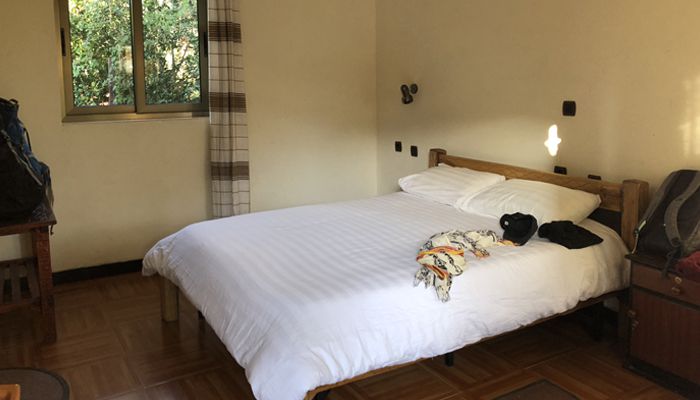
There are several accommodation options in Lalibela and you can choose from budget or luxury accommodation depending on your preference.
Selam Guest House (Budget option)
Nice and cozy place with gardens outside the rooms. The guest house is located in a quiet neighborhood close to the Lalibela churches. The rooms are comfortable with hot running shower and beds. You can also get a professional guide with the help of the owner of the guest house. The cost is relatively low, making it a good choice if you are on a budget.
Features
Free high-speed internet (wifi), restaurant, laundry service, free parking, bar/ lounge.
Blue Nile Guest House
Blue Nile guest house is located above the rock-cut churches of Lalibela. It is comfortable and about a three-minute walk to the churches. They have hot showers and comfortable beds with spacious rooms. The guest house is also close to the centre of the city in case you need to use an ATM or use the restaurant. The in-house restaurant also serves good meals.
Features
Free high-speed internet (wifi), room service, airport transfers, business centre with internet access, shuttle bus service, pets allowed.
Old Abyssinia Lodge (Luxury accommodation)
This high-end accommodation gives you a nice sunset view of the mountain surrounding Lalibela. The rooms are large, with comfortable beds, bathrooms with hot shower.
Features
Restaurant, bar/ lounge, room service, free parking, free high-speed internet (wifi), airport transportation, business centre with internet access, laundry service, meeting rooms, shuttle bus service, dry cleaning service.
Panoramic View Hotel
Definitely one of the best hotels in Lalibela with state of the art rooms and spectacular views from the balcony into the Lasta mountains. The room is spacious with comfortable beds and hot showers. The staff is really helpful and the hotel is just a 3-minute drive from Lalibela airport.
Features
Free high-speed internet (wifi), free parking, bar/ lounge, airport transportation, meeting rooms, restaurant, concierge, public wifi, laundry service, dry cleaning service.
Where to Eat
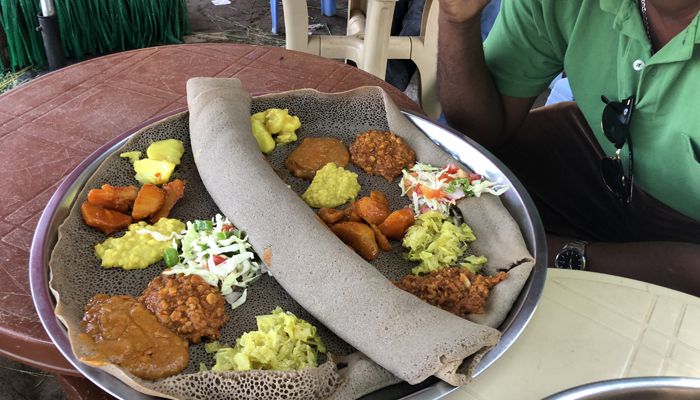
Lalibela has a good number of restaurants and cafes with delicious meals to delight your taste buds. The views from these restaurants also add to the experience leaving you with remarkable memories. Don’t forget to try Ethiopia’s finest: Injera and all the goodness that comes with it. Also, have an avocado papaya smoothie. Finally, don’t leave without having an Ethiopian coffee.
Ben Abeba
Awarded certificate of excellence three consecutive years, this restaurant has an amazing architectural design with a great view of the surrounding landscapes. They offer local and international cuisines and is a great place to have a romantic dinner at moderate prices.
Kana Restaurant And Bar
The surrounding view of this restaurant overlooking the valley feeds your mind as the sumptuous meal nourishes your body. They offer both local and international cuisines. It is definitely worth trying.
Segenet Cafe And Restaurant
This restaurant offers Italian, American, African, Ethiopian and European cuisines. It’s one of the newly established restaurants located in the middle of the city near the Ethiopian airline office. The meals are great and the staff is receptive and friendly.
Seven Olives Hotel Restaurant
This restaurant has been owned by Lalibela’s church diocese administration for over six decades. They offer local and continental cuisines and even offer special diets for vegetarians. The meals are great and the view is stunning.
Entrance fee to Lalibela
The entrance fee to Lalibela rock churches is 1000 birr (around US50$) per adult and 500 birr (around US25$) per child. Note that this payment is valid for 5 days with access to all 11 churches of Lalibela.
Climate and Weather
Like most other cities in Ethiopia, the weather condition in Lalibela is warm and temperate. The best time to visit Lalibela considering the weather is from November to April, since the rainy season (July to August) brings soaring temperatures and humid conditions. Travelling during the shoulder months (March, April, May, June, September, and October) can be quite economical, but you may experience the occasional short bursts of rain.
What to Wear
Due to the altitudinal differences between high and low lands, you should make preparations for temperature changes when exploring Ethiopia. You will need lightweight clothing for the lowlands, and medium weight clothing for the hill country. You should also come along with at least one pullover or sweater as Lalibela is known for its dramatic temperature drop when the sun goes down. For ladies, when visiting the churches in Lalibela, it’s important you wear clothes that cover the legs so no shorts. A nice, breathable leggings are a good option as jeans can be too hot also. Also, avoid sleeveless, midribs, and see-through- a nice cotton shirt should do the trick. For footwear, it’s best to wear rubber, trekking shoes, or anything similar with a nice grip. Slippers will cause you pain walking on rocky surfaces.
Photo, Video, Drone
For photographs, the best time is usually early in the morning between 6-7am especially for St. George’s church so you can take unobstructed photos. The afternoon period gets really crowded. Besides most of the interesting activities are highlighted during the morning mass and prayers. It’s allowed to take photos and videos everywhere, including inside the churches. Taking videos is permitted too if you’re using a phone or an amateur type device. A professional-looking equipment might be questioned. Use of drone is strictly not allowed.
Extra Tips
To get the most of your trip when visiting Lalibela, do well to hire a tour guide to show you around and give you a detailed background history about the churches and whatever you need to know. You can easily hire an official tour guide at the ticket office. Prices vary for both official and unofficial guide but the official guides are guaranteed to be knowledgeable and reliable.

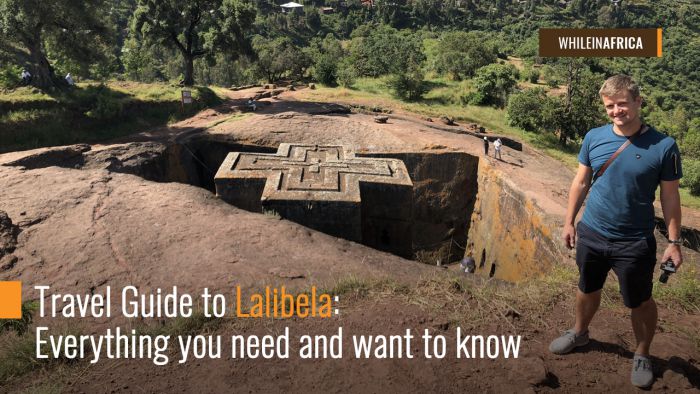


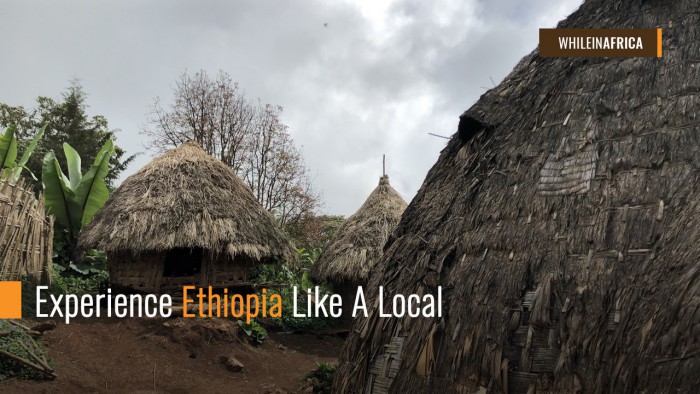
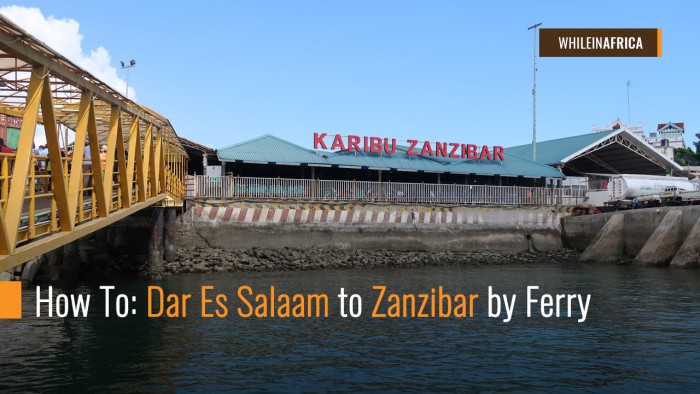


very good and detail information about lalibela.
Hello, Erika and Martin. I really appreciate the amazing introduction of Lalibela.
I wonder if there are any local community groups that I could get in touch with since we are trying to do a project about their local building.
Thanks in advance.
Hi not that we know of. I suggest to keep in touch with a local tour operator for help, they would know where to reach out 🙂
All was good but there are so many hotels and homestays you miss on it….
yes I’m sure as we were only there once. Thanks